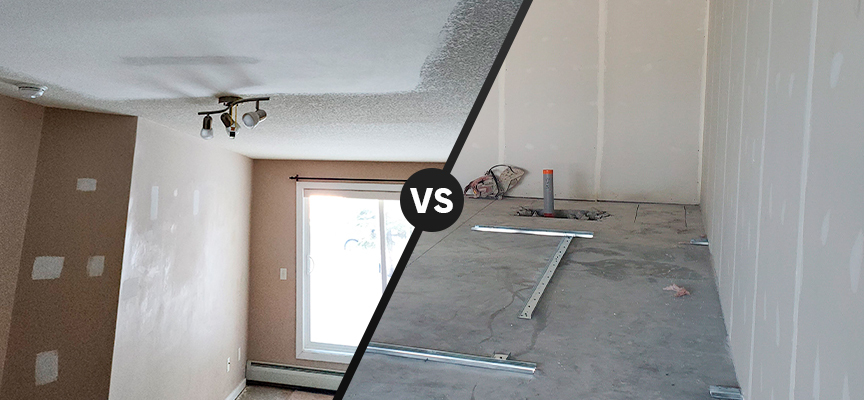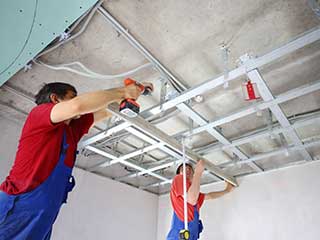Combine the skill of drywall contractors and elegant Interior Painting for a inviting home look.
Discover the most effective Practices for Successful Drywall Repair Service and Setup
The art of drywall fixing and installment needs a mix of skill and precision. Understanding the important tools is important for attaining a seamless coating. Comprehending the detailed procedure can make a substantial difference in the final outcome. Correct techniques for taping and mudding are additionally vital. What stays is the understanding of maintenance that ensures longevity. These aspects together create a sleek result worth exploring additionally.

Important Devices for Drywall Repair and Setup
When embarking on drywall repair service and installation, having the right devices can considerably enhance the effectiveness and high quality of the job. An utility blade is important for reducing drywall sheets specifically, while a drywall saw can help in making a lot more elaborate cuts. Taping knives, available in various sizes, are crucial for using joint substance smoothly and uniformly. A drywall sander, preferably with a dust collection feature, helps achieve a sleek finish, decreasing the requirement for comprehensive clean-up.
In addition, a determining tape assurances precise measurements, and a degree guarantees that setups are straight and plumb. Safety and security equipment, consisting of dust masks and safety glasses, should not be forgotten to secure versus particles and dirt. Finally, a stud finder help in situating framing participants, assuring safe installment. By outfitting oneself with these crucial devices, the repair and setup procedure becomes much more workable and leads to a professional-quality outcome.

Step-by-Step Guide to Patching Holes
Patching holes in drywall calls for a methodical technique to ensure a smooth fixing. The area around the hole must be cleaned and any kind of loose debris got rid of. For little openings, a putty blade can be used to use a light-weight spackle, pressing it right into the opening and smoothing the surface area. After it dries, sanding is important to create a level coating. For bigger openings, a patch of drywall may be essential. This entails cutting an item of drywall a little larger than the hole, safeguarding it to the wall with screws, and making use of joint compound to cover the seams. When the substance dries out, it ought to be sanded smooth. Ultimately, priming the patched area before paint will guarantee an also surface. Adhering to these actions will certainly result in a professional-looking repair service that mixes perfectly with the surrounding wall.
Strategies for Seamless Drywall Setup
Achieving smooth drywall installment demands cautious planning and implementation. It is essential to cut and determine drywall sheets precisely to decrease spaces. Making use of an utility knife, installers ought to score the board before snapping it along the cut line, guaranteeing tidy sides. Effectively lining up the sheets is important; beginning from the top and functioning down helps keep uniformity.
Fastening drywall to the studs requires consistent spacing, commonly every 16 inches, making use of screws instead of nails for better hold. This approach decreases the threat of stands out in time. In addition, surprising the joints in between sheets enhances architectural honesty and minimizes the presence of joints.
Using the appropriate density of drywall for certain locations-- such as moisture-resistant types in restrooms-- further contributes to a perfect coating. Complying with these techniques will bring about a professional-looking and smooth installation, setting the stage for the subsequent completing procedures.
Ending Up Touches: Insulation and Mudding
Completing touches, such as mudding and taping, play an important duty in attaining a polished drywall surface area. Insulation involves applying a slim strip of drywall tape over the joints and seams, ensuring a seamless appearance. This process assists prevent splits and develops a strong bond between drywall sheets. It is important to pick the appropriate sort of tape, with paper and fiberglass mesh being the most typical choices.
Mudding, or using joint compound, complies with taping. This substance fills in gaps and smooths out the surface for an uniform finish. It is typically used in multiple layers, with each layer needing to published here dry prior to fining sand. Appropriate method includes feathering the sides to mix the compound into the surrounding drywall, reducing visibility.
When completed correctly, taping and mudding enhance both the visual and architectural honesty of the drywall setup, leading to a professional-quality coating.
Tips for Keeping Your Drywall After Installation

Furthermore, maintaining a regular indoor moisture degree can protect against warping or mold and mildew growth. Utilizing a dehumidifier in damp locations, like basements, is advisable. It's also valuable to regularly repaint areas that show wear, as this safeguards the underlying product. When relocating furniture or installing components, care should be worked out to stay clear of damaging the drywall. By following these upkeep ideas, property owners can prolong the life of their drywall, guarding it continues to be an eye-catching function of their interiors.
Often Asked Questions
What Security Equipment Is Required for Drywall Repair Service and Installation?
For drywall repair service and setup, vital security gear includes safety and security goggles to protect eyes, dirt masks to avoid inhalation of bits, gloves for hand security, and knee pads for comfort throughout extended kneeling. drywall contractors.
Exactly how Do I Determine the Drywall Thickness Needed for My Task?
To figure out the drywall thickness required for a project, one must consider the wall's architectural requirements, local building codes, and the planned usage of the space, commonly selecting 1/2-inch or 5/8-inch drywall.
Can I Repair Drywall Without Removing Furnishings From the Space?
Yes, drywall can be fixed without removing furnishings from the space. Careful planning and safety measures can reduce mess, enabling efficient fixings while my company maintaining surrounding items safe from dust and damages during the process.
What Kinds of Drywall Are Best for Various Settings?
Moisture-resistant drywall is ideal for kitchens and shower rooms, while soundproof drywall suits shared walls in houses. Fire-rated drywall is best for garages, and conventional drywall works well as a whole living locations, making certain durability and suitability for various environments.
For how long Does It Consider Drywall Mud to Dry Entirely?
Drywall mud normally takes 24 to 2 days to dry totally, relying on factors like moisture and temperature (Interior Painting). Thicker applications might need longer drying times, while thinner layers can dry much more promptly. Proper air flow help drying
The art of drywall repair work and setup requires a blend of ability and accuracy. When carrying out drywall repair and installation, having the right tools can greatly boost the effectiveness and quality of the job. An energy blade is vital for cutting drywall sheets precisely, while a drywall saw can help in making much more complex cuts. Accomplishing smooth drywall installation needs mindful planning and execution. Moisture-resistant drywall is ideal for cooking areas and bathrooms, while soundproof drywall fits shared walls in apartments.